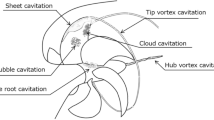Abstract
The experimental and numerical investigations on electromagnetic control of cylinder wake have been performed in this paper. Experiments were conducted in a rotating annular tank filled with a low-conducting electrolyte. A cylinder with an electromagnetic actuator mounted on the surface was placed into the electrolyte. Force measurements have been carried out by strain gages attached to a fixed beam to which the hydrofoil is suspended and flow fields are visualized by dye markers. Based on the Navier-Stokes equations considering the electromagnetic body force, i.e. Lorentz force, in the exponential-polar coordinates, the numerical investigations were carried out by means of an Alternative-Direction Implicit algorithm and a Fast Fourier Transform algorithm. Experimental results have shown the same tendency with the numerical results. For the constant Lorentz forces, called open-loop control, the vortex shedding was fully suppressed. Meanwhile, the weak street disappeared and the drag force was reduced. Based on the Navier-Stokes equations, an adjoint-based ensemble optimization of control algorithms was developed and adjoint equations in the exponential-polar coordinates were derived. The equations were solved by numerical algorithm as mentioned above. The evolutions of the flow field in the control process were discussed according to the calculated variable optimal interaction parameters.
Similar content being viewed by others
References
Roshko A. On the weak and drag of bluff bodies. J Aeronaut Sci, 1955, 22: 124–132
Williamson C H K. Vortex dynamics in the cylinder wake. Ann Rev Fluid Mech, 1996, 28: 477–539
Kwon K, Choi H. Control of laminar vortex shedding behind a circular cylinder using splitter plates. Phys Fluids, 1996, 8: 479–486
Strykowski P J, Sreenivasan K R. On the formation and suppression of vortex ’shedding’ at low Reynolds numbers. J Fluid Mech, 1990, 218: 71–107
Tokumaru P T, Dimotakis P E. Rotary oscillatory control of a cylinder wake. J Fluid Mech, 1991, 224: 77–90
Roussopoulos K. Feedback control of vortex shedding at low Reynolds numbers. J Fluid Mech, 1993, 248: 267–296
Li Z J, Navon I M, Hussaini M Y, et al. Optimal control of cylinder wakes via suction and blowing. Computers Fluids, 2003, 32: 149–171
Lecordier L C, Browne L W B, Le Masson S, et al. Control of vortex shedding by thermal effect at low Reyolds numbers. Exp Therm Fluid Sci, 2000, 21: 227–237
Wu C J, Xie Y Q, Wu J Z. “Fluid roller bearing” effect and flow control. Acta Mech Sin, 2003, 19: 476–484
Wu C J, Wang L, Wu J Z. Suppression of the von Karman vortex street behind a circular cylinder by a traveling wave generated by a flexible surface. J Fluid Mech, 2007, 574: 365–391
Gailitis A, Lielausis O. On a possibility to reduce the hydrodynamical resistance of a plate in an electrolyte. Appl Magnetohydrodynamics, 1961, 12: 143–146
Weier T, Gerbeth G, Posdziedch O, et al. Experiments on cylinder wake stabilization in an electrolyte solution by means of electromagnetic forces localized on the cylinder surface. Exp Therm Fluid Sci, 1998, 16: 84–91
Kim S J, Lee C M. Investigation of the flow around a circular cylinder under the influence of an electromagnetic force. Exp Fluids, 2000, 28: 252–260
Chen Z H, Fan B C. Numerical investigation on wake of cylinder covered with electromagnetic actuator (in Chinese). Acta Mech Sin, 2002, 34: 978–983
Fan B C, Zhou B M, Chen Z H. Electromagnetic control to cylinder wake (in Chinese). Chin J Appl Mech, 2005, 22(4): 522–526
Zhou B M, Fan B C, Chen Z H, et al. Flow control effects of electromagnetic force in the boundary layer (in Chinese). Acta Mech Sin, 2004, 36(4): 472–478
Abergel F, Temam R. On some control problems in fluid mechanics. Theor Comput Fluid Dyn, 1990, 1: 303–325
Gunzburger M D. Perspectives in Flow Control and Optimization. Philadelphia, PA: SIAM, 2003
Bewley T R, Moin P, Teman R. DNS-based predictive control of turbulence: An optimal benchmark for feedback algorithms. J Fluid Mech, 2001, 447: 179–225
Berger T W, Kim J, Lee C. Turbulent boundary layer control utilizing the Lorentz force. Phys Fluids, 2000, 12(3): 631–649
Author information
Authors and Affiliations
Corresponding author
About this article
Cite this article
Zhang, H., Fan, B., Chen, Z. et al. Open-loop and optimal control of cylinder wake via electromagnetic fields. Chin. Sci. Bull. 53, 2946–2952 (2008). https://doi.org/10.1007/s11434-008-0394-2
Received:
Accepted:
Published:
Issue Date:
DOI: https://doi.org/10.1007/s11434-008-0394-2




